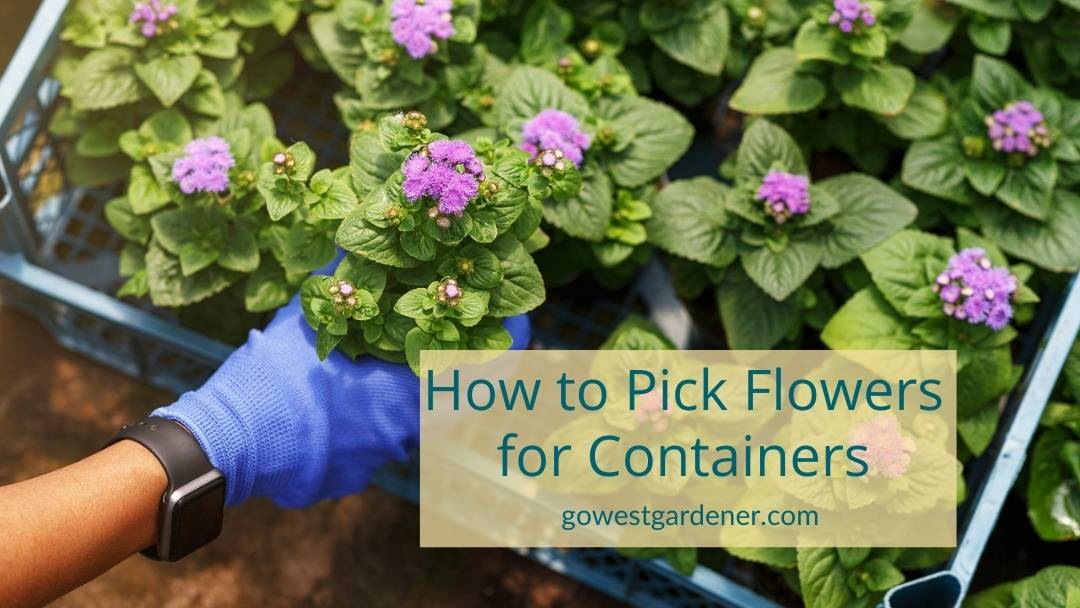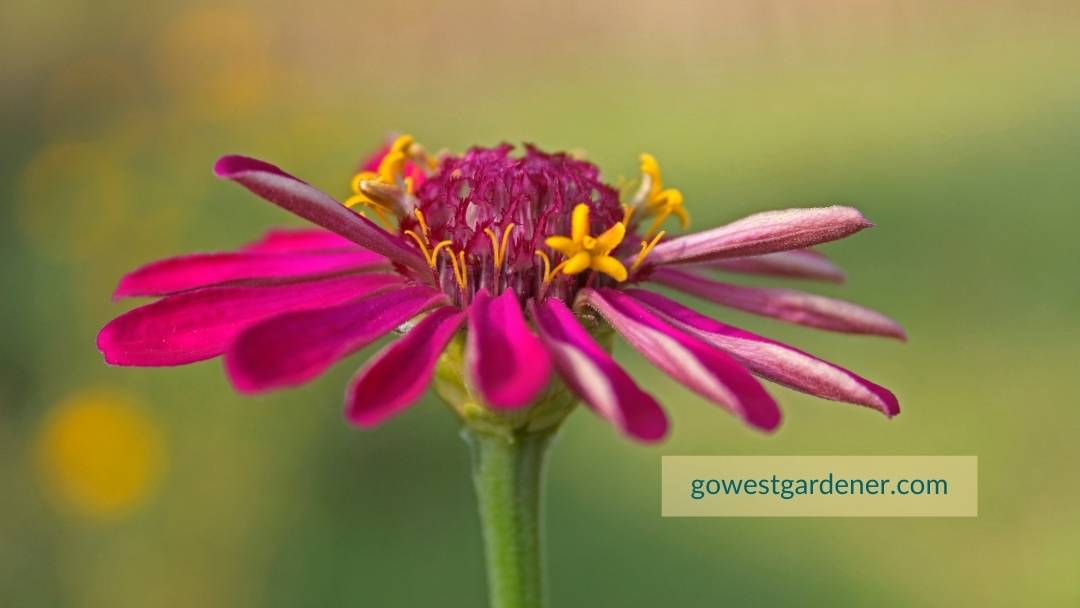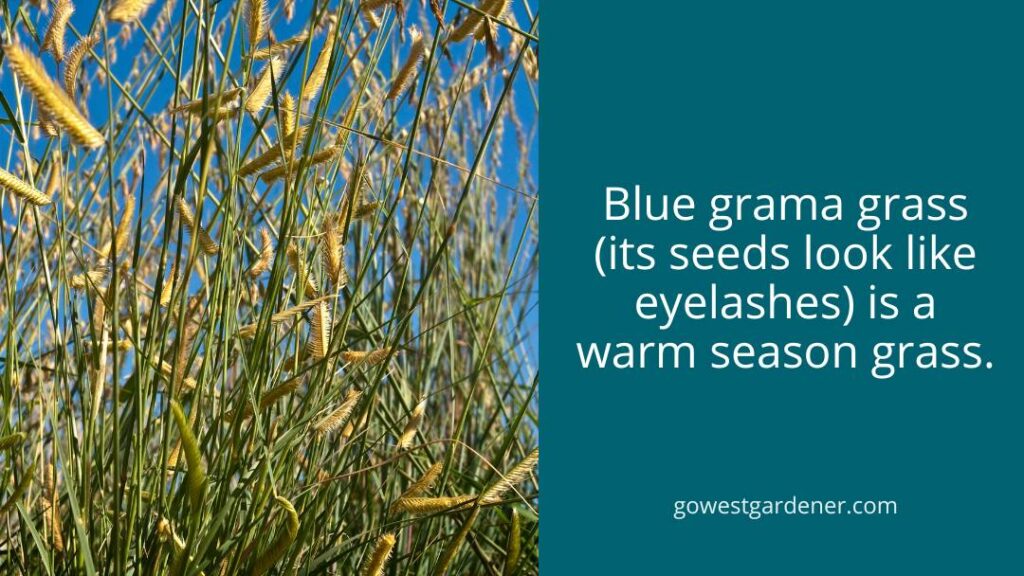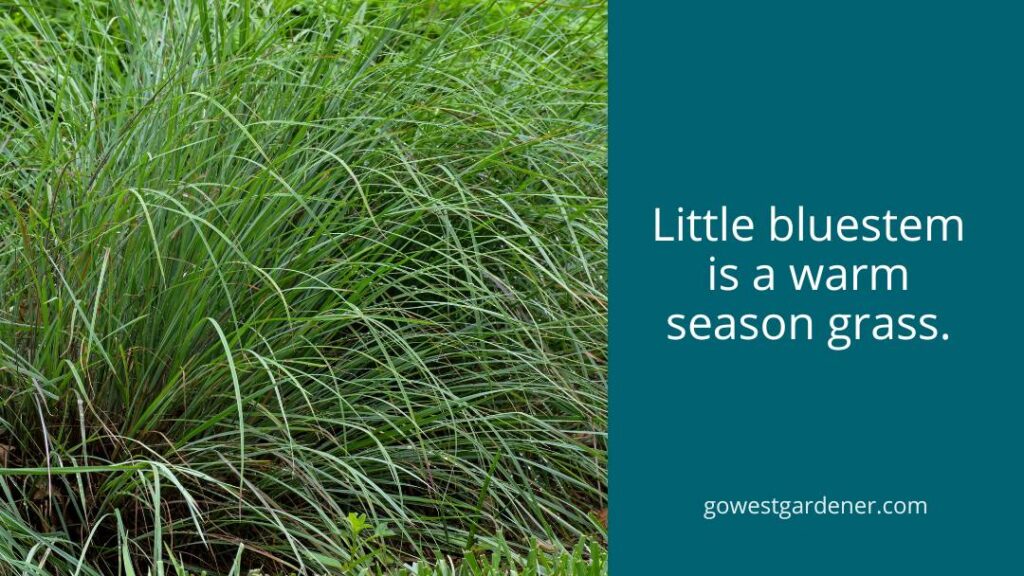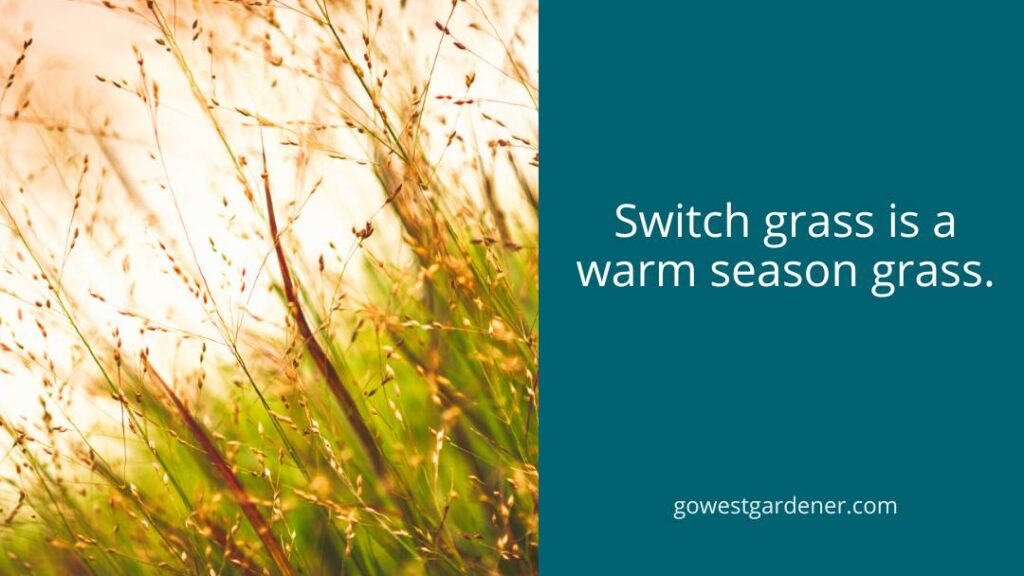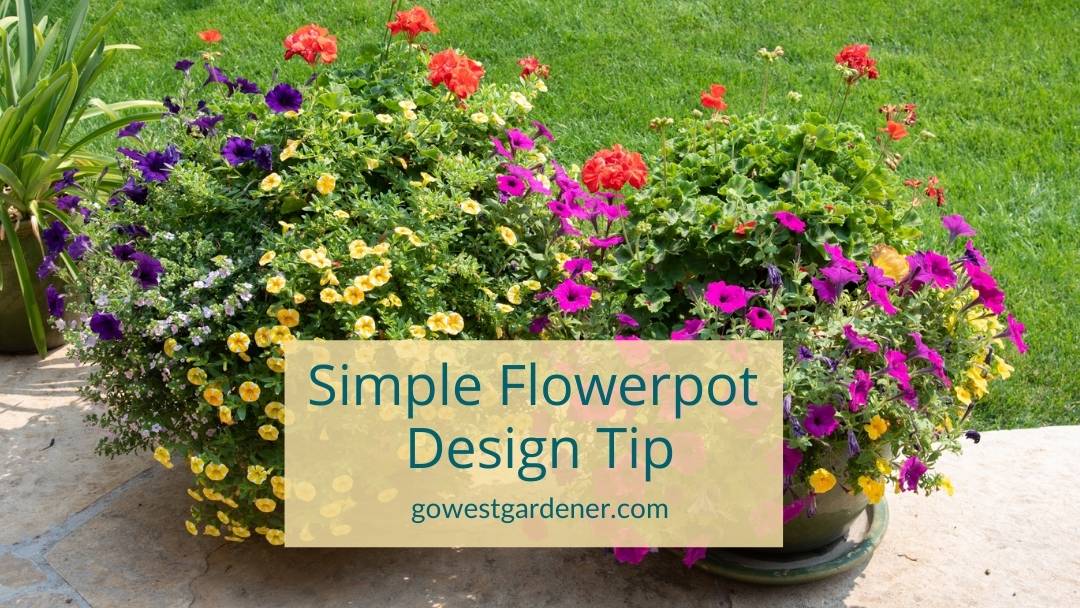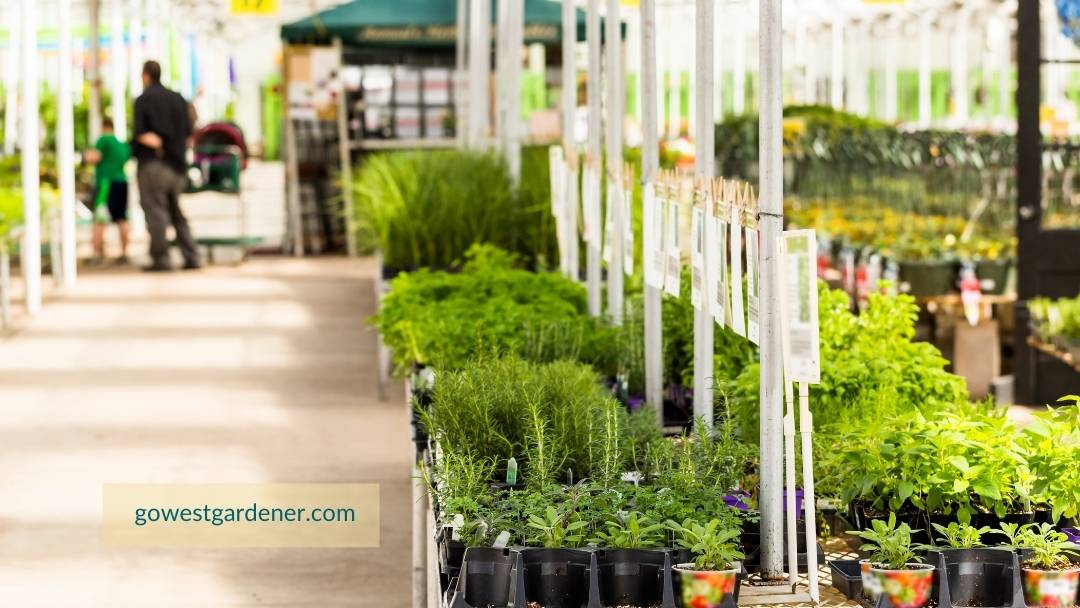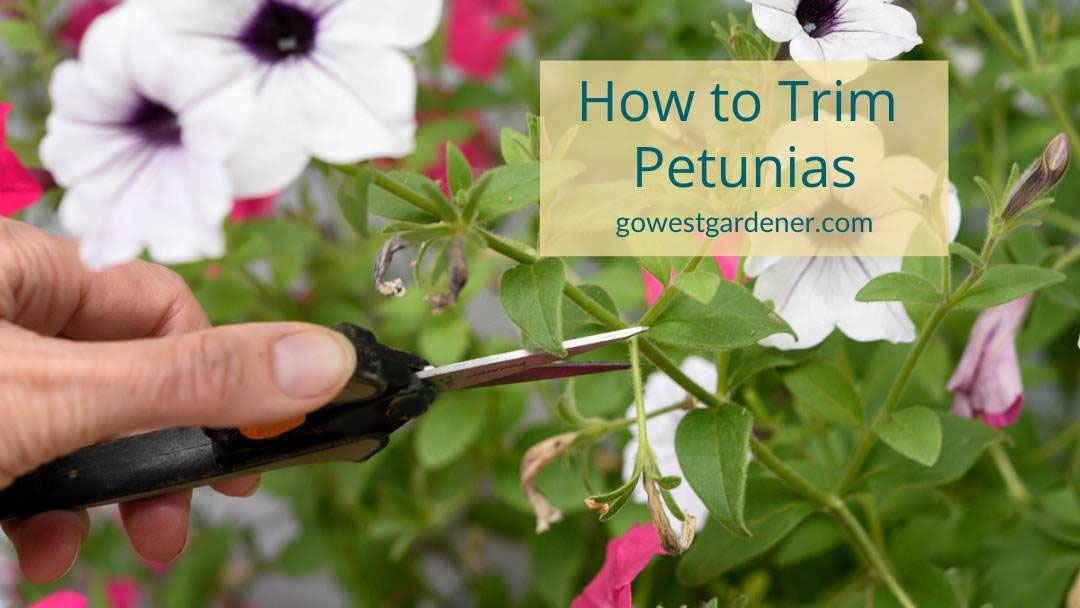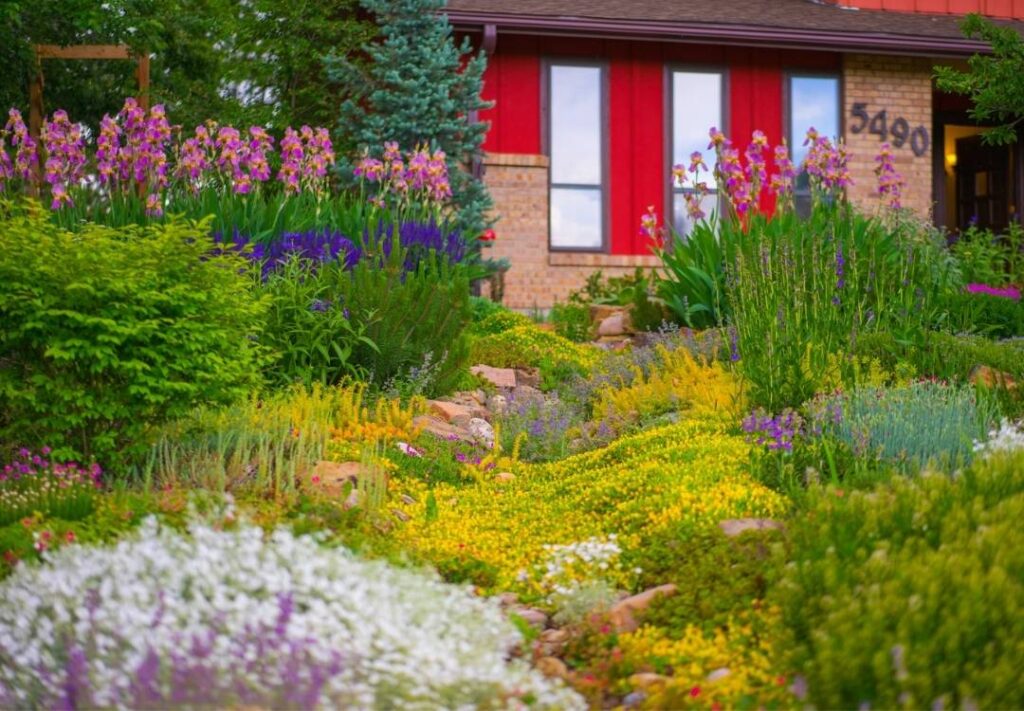
by Ann at Go West Gardener | Updated: Jun 20, 2025 | Best Flowers for Colorado, Utah & Similar States, In-ground garden, Waterwise Gardening in the Intermountain West, Western Container Gardening With Flowers
This cutie is known as Lantana.
This colorful flower reminds me of a delicious bowl of sherbet.
It isn’t a flower you want to eat, though — no matter how yummy it looks.
It’s actually a little poisonous. Be careful where you plant it if you have wee ones or dogs.
The butterflies and hummingbirds love Lantana, though!


Lantana is an “annual” in western states like Colorado and Wyoming.
This means it blooms all summer, but it doesn’t return next year.
Add this flower to your flowerpots or in the ground for a BIG pop of color.

Here’s why to add this colorful beauty to your summer garden…
- Lantana can take the heat, so it’s a good flower to try in your garden hot spots.
- It’s easy going. Lantana grows well in sunny locations, as well as partly shady spots.
- You’ll find it in many colors, from vibrant oranges and electric pinks, to calming yellows and purples.
- It tolerates drought, which is good in our semi-arid climate.
- Lantana attracts butterflies and hummingbirds. Yay!
- This plant is deer resistant, so it isn’t the first choice of deer for munching.

Do you live in another region of the country?
If you live outside the Rocky Mountain region (like in the Southeast or Southwest), ask at your local garden center whether Lantana can be grown where you live.
There are some places where it isn’t allowed.
Related topics that may interest you:


by Ann at Go West Gardener | Updated: Jun 20, 2025 | Gardening Tips and Tricks, Western Container Gardening With Flowers
So, you walk into your local garden center …
You’re all ready to pick 3-5 flowers for your planters, but suddenly, you see HUNDREDS of flower choices.
You’re looking at row, after row, after row of flowers.
How are you supposed to know which flowers to pick??

No worries, you’ve got this!
In this tip, you’ll discover 4 proven questions to help you start narrowing down your choices, so you can pick flowers for your planters that are more likely to last — particularly in our tough western growing conditions.
Watch my video below or scroll down for the article.
Here’s what to think about when picking flowers, so your flowers are more likely to last — particularly in tough western states like Colorado and Utah.
#1: How much sun will my planters get where I place them?
Some plants love the sun. In fact, they need the sun in order to give you colorful blooms.

But other plants?
Not so much.
They actually prefer shadier conditions.
Before you go to the garden center, take a look at where your planter will be and ask yourself:
How much sunlight are my pots getting and what times of day?
That way, when you get to the garden center, you can look for flowers that love sun or flowers that prefer shade.
Look at the plant tags tucked in the flowers. The plant tags should tell you whether the flowers like sun, shade or something in between.
If you’re ever unsure of how much sunlight different flowers need, you can always ask at the garden center. People are usually happy to help you.
In western states like Colorado and Utah, our sunlight is more intense on our plants in than other parts of the country because we’re gardening closer to the sun at elevation. To better understand what “sun” and “shade” mean here, check out my free mini-training: The Top 5 Mistakes in Flowerpot Gardening (And How to EASILY Avoid Them).
#2: The next question for you is, do you have wildlife in your area?
And specifically, I mean deer.

Here’s why I ask.
Some plants have developed defense mechanisms, so they’re less likely to be eaten by deer.
For example, they may have a scent or a taste that deer don’t like.
If you know that Bambi and his friends like to stroll through your neighborhood like it’s an all-you-can-eat lunch buffet, be sure to ask where the deer resistant flowers are when you go to the garden center.
(Sometimes these flowers are grouped together at the garden center. Sometimes they aren’t.)
The key word here is “deer resistant.”
If an animal is hungry enough, it will eat anything that’s available to it.
Nonetheless, you’ll give yourself a little bit of an advantage if you know that your neighborhood has deer, and you seek out deer-resistant flowers.
Okay, next question:
#3: Do you get really hot summers? Or are you more likely to get summer frosts?
Here’s why I ask.
Some flower plants do really well in the heat. They can handle it like a champ, like the zinnias below.

Other flower plants prefer cooler temperatures and are happier in sweater and jeans weather.
In fact, when temperatures get down around freezing, they’re going to be a lot more forgiving than some other plants (like pansies or violets below).

Seldom are these two the same.
So, if you know you live somewhere hot and you’re putting your flower plants out in the afternoon sun, then you want to ask for “heat tolerant” annuals or “heat resistant” annuals.
But if you know that you live at a higher elevation with a much shorter growing season and you have the chance of much colder temperatures, then you’re more likely to want to ask for “frost tolerant” annuals or “cold hardy” annuals. These are your flowers that are more forgiving at colder temperatures.
Okay, last question to ask yourself to set yourself up for more success with your planters or pots.
And it’s this:
#4: How much energy do you want to put into growing flowers?

All flowers need a little bit of your energy, right?
You need to water your flowers.
You may need to remove the dead blooms.
And you may need to fertilize them from time to time.
But, if you know you’re not-so-great about watering or you’re not-so-great at removing those dead blooms, there are actually flowers you can choose that are almost designed for you.
For example, let’s say that the idea of trimming off dead blooms on a flower sounds like a lot of work to you. (This is known as “dead heading.”)
Well, did you know there are some flowers that lose their petals on their own?
Often times, they’re called “self-cleaning” flowers. They lose their blooms and take care of it all themselves, so you don’t have to do a thing.
When you look at flowers at the garden center, look for words like “self cleaning” or “no deadheading” on their plant tags. (Not every plant tag says it, so it’s okay to ask about self-cleaning flowers too!)
If you know you’re not so great about watering…
You may want to ask about flower plants that need less water.
Or, you may want to invest in planters that contain self-watering reservoirs. You could run mall hoses from your irrigation system (known as “driplines”) straight into your planters or pots.
There are things you can do to pick plants that are much more suited for your lifestyle.
Related tips that may interest you:


by Ann at Go West Gardener | Updated: Apr 24, 2025 | Flower Garden Basics
Have you noticed…
… that some of your plants are overachievers in the spring—eager to emerge from the ground in all their leafy glory? Meanwhile, other plants don’t seem to be doing much AT ALL.
As plant lovers, it’s natural for us to look at the latter and wonder:
Hey, are you even alive?
Did we do something wrong?
Wait, are you ghosting us??
The biggest culprits are often ornamental grasses.
Ornamental grasses are the showy grasses you plant in your garden for year-round interest.
Some grasses burst from the ground in the spring looking all green and lush.
Others? Not so much.
They’re more like teenagers on a Saturday morning: S-L-O-W to wake up.
I had a neighbor stop me in early April and glumly share: “I don’t think my ornamental grasses made it through winter.” (I think she took it personally.) But nope, her grasses are alive and well! Just slow to wake up.
So, if you’ve ever wondered, “Why aren’t my ornamental grasses growing?”, here’s a helpful thing to understand about grasses.
Some grasses grow when temperatures are mild. These “cool season” grasses are off to the races in the spring. Then, they go dormant when it gets hot, meaning they aren’t actively growing over the summer.
Other grasses are in their happy place in the heat. These “warm season” grasses green up when it gets hot, like in the late spring and summer.
Want some examples?
You may recognize the ornamental grass below: Karl Foerster feather reed grass. It’s used in a lot of landscapes. It’s a popular ornamental grass that thrives in mild temps. It goes dormant in the summer heat.

The lawn grass, Kentucky bluegrass, is a cool season grass too. It grows in cooler temps, going dormant in the summer heat.
Little bluestem grass, blue grama grass, and switchgrass are all examples of warm season grasses. They thrive in the heat.


So, if your ornamental grasses aren’t growing in the spring…
They may be warm season grasses that are waiting for the heat.
If your ornamental grasses aren’t growing in the summer…
They may be cool season grasses that have gone dormant in the heat. They may be waiting for cool temperatures to return.
The Colorado State University Extension has a table that notes which ornamental grasses are cool season and which are warm season. You can use it to check the grasses in your own garden. (Unfortunately, the chart doesn’t have photos, so you need to know what kind of grasses you have. If you saved your plant tags, great!)
If you’re interested in the science behind cool and warm season grasses, the University of Illinois Extension has a quick write-up.
Related tips that may interest you:


by Ann at Go West Gardener | Updated: Apr 24, 2025 | Garden design Ideas, Gardening Tips and Tricks, Western Container Gardening With Flowers
Looking for a design tip to make your flowerpots look prettier this summer?
Combine flowers of different heights!
Planting flowers of different heights can help you create a lot of visual interest.
Think of a city skyline or a beautiful mountain range. There are different layers that make things interesting, right?
The same is true for the flowers in your flowerpots.
In gardening lingo, this design concept is known as thrillers, fillers and spillers.
- Thrillers are your tall flowers.
- Fillers are your mid-size flowers.
- Spillers are your flowers that spill out of the flower pot.

if you find these words hard to remember or confusing, then…
Think about this flowerpot design tip in western terms.
You want your flowerpots to have mountains, foothills and waterfalls.
Your mountains are your tall flowers that add height and a strong focal point to your flowerpots.
For example, you could use a tall ornamental grass or a gorgeous red canna lily, like the one pictured below. (Just like the mighty peaks in a mountain range, these tall flowers are your thrillers.)

Your foothills are your mid-size flowers that add interesting textures or pops of color, like the yellow Marguerite daisies below. (These flowers fill your flowerpots.)

And your waterfalls are your flowers that spill out of your flowerpots and cascade down the sides, like the light-green licorice plant and lime-green sweet potato vine in the photo below. (These flowers are your spillers.)

When you go to the garden center, how do you know whether a flower will make a good mountain, foothill or waterfall?
1. Notice which direction the plant is growing.
Even in the garden center, you can usually tell whether a flower is growing upright or growing down.
If you hold up a plant that seems to be trailing from its container, it could be a great flower to spill from your flowerpots like a waterfall. The pink petunias below are a good example.

2. Look at the plant tag to check your flower’s final height.
Often times, the size of the flower in the garden center is only a fraction of how big that flower will grow by the end of the summer.
For example, a flower that’s about 8” tall in the garden center may grow several feet tall over the summer!
When you pick up flowers at the garden center, check their plant tags to see how tall they’ll grow.
If you pick up a flower that grows 14” to 36” tall, it could make a great mountain.
Flowers that aren’t quite as tall — 6” to 14” in height — can make great foothills.
Keep in mind, the height suggestions above are just that: Suggestions! Gardening is personal, so you can do whatever looks good to you.
For this flowerpot design tip to work, do you have to include mountains, foothills AND waterfalls?
This is a matter of personal preference.
Personally, I love all three together.
But you can definitely go with just two.
The flowerpots below are hanging in my neighbor’s yard. The pots are small, so she just used foothills and waterfalls. She didn’t have enough room for all three.

And the flowerpot below is really big, but the gardener made a strong statement with just mountains and foothills.

If you liked this flowerpot design tip, you may also like:


by Ann at Go West Gardener | Updated: May 9, 2024 | Best Flowers for Colorado, Utah & Similar States, Gardening for Pollinators, In-ground garden
Who else loves Columbine flowers?
(I have both my hands up.)
You’ll see Columbine flowers growing along alpine hiking trails in the Rocky Mountains… and in western gardens.
When I see them on mountain trails, I want to turn into Julie Andrews at the start of The Sound of Music, twirling around with my arms in the air, singing about the hills being alive. They make me giddy every time I see them.

Columbine flowers are perennials. This means they come back every year.
If you’re like me, you may think of Rocky Mountain Columbines first. They’re the bluish-purple and white flowers you’ll often see on mountain trails (like the ones pictured above). Rocky Mountain Columbines grow well in moist mountain meadows.
But you can find Columbine flowers in different types and colors.
There’s even a type of Columbine that can handle our hot, semi-arid summers at lower elevations in the intermountain west. (Scroll down for the scoop!)
Typically, Columbine flowers bloom in May and June at our lower elevations in states like Colorado.
And at our higher elevations, these flowers usually bloom in June and July.

Columbines are a WONDERFUL hummingbird magnet.
If you ever get a chance to visit the Betty Ford Alpine Garden in Vail, Colorado during the summer, make a beeline to the Columbine flowers.
If they’re in bloom, you’ll often be able to watch the hummingbirds blissfully zip from flower to flower.
It’s heavenly.
Tip: If you want to plant flowers that attract hummingbirds to your garden, add Columbines to your list.

Happy plants tend to live longer, so let’s chat about how to keep your Columbines happy.
The big thing is planting your Columbines in the right place in your garden.
Our summers can get really hot in our lower elevations in western states like Colorado and Utah. If you live someplace hot, your Columbines will likely prefer spots in your garden that have “partial shade” or “shade.” (A helpful guideline is 4 hours or less of sunlight. Avoid planting them in afternoon sunlight, which can be too hot.)
For example, you may want to plant them in the shade of a leafy tree.
They also like it when your dirt (which we’ll call “soil”) is moist and drains well.
To help keep your soil moist, it helps to put a layer of “mulch” (like wood chips or mini-bark) on top. You can find mulch at your local garden center.
But there IS a type of Columbine that can handle sunnier spots…
And it’s a much better fit for our gardens in the hot, semi-arid parts of the intermountain west!
If you’re looking for a Columbine flower that grows well in sunshine, ask at the garden center about Denver Gold® Columbine.
This plant’s official botanical name is: Aquilegia chrysantha ‘Denver Gold’.
Denver Gold® is a showy, yellow Columbine that flourishes in sunny locations.
It grows well in our tricky western soils up to elevations of about 9,000 feet.
In the photo above, you’ll see Denver Gold® Columbines (the tall, yellow flowers) planted next to purple flowers known as bearded irises.
Isn’t this a pretty combo?
Denver Gold® Columbines give you beautiful yellow flowers in May and June in our lower elevations. And if you trim off the dead blooms, you may get more flowers later in the summer as well.
It’s native to the canyon lands in the Southwest.

In the photo above, Denver Gold® Columbines (the yellow flowers) are planted alongside a bluish-purple flower known as Salvia (Salvia sylvestris ‘May Night’).
Another showy combo!
If you live in another region of the country…
Ask at your local garden center whether Columbines will grow well where you live.

Related tips that may interest you:


by Ann at Go West Gardener | Updated: Apr 24, 2025 | Flower Garden Basics, In-ground garden
Spring can be one of the best times to plant perennials — the flowers that come back.
“Cool temps are ideal for planting perennials…” wrote David Salman, respected western plantsman of Waterwise Gardening LLC, in 2022. “Perennials thrive in cool weather, putting their energy into growing robust root systems.”
And healthy root systems lead to healthy plants!
When you plant your perennials on mild spring days with cool nights, their roots have a chance to get a head start before summer. They’re better prepared when our roasty summer temps arrive.
So, the question is:
When should you plant perennials in the spring?
I’d love to give you a simple answer—or better yet, a date.
Yep, a specific date would be nice. But Mama Nature makes her own rules, and she can be a fickle gal, especially in Colorado and similar western states. Plus, it depends on where you live and what you’re planting.
Nevertheless, here are helpful guidelines.
You should be able to plant perennials when all of the following occur:
1) Your ground isn’t frozen.
According to the Colorado State University (CSU) Extension, you should theoretically be able to plant hardy perennials when you can work the soil (your dirt). In other words, you can get a shovel in the ground.
If the ground isn’t frozen, your plants’ roots also should have access to water.
In the Front Range of Colorado, this is often April.
2) The ground isn’t too damp.
Digging in wet dirt can compact your soil. (This is a fancy way of saying: You can accidentally smoosh your dirt.)
Compaction is a common issue in clay soil—which many of us have in Colorado and the intermountain west. It can cause problems that last a long time. For example, compacted soil can make it tough for water and air to get to your plants’ roots.
If you’ve been getting snow or rain, hold off on digging in the dirt. Let your soil dry for a bit.
3) Your perennials have been actively growing outside for a while.
This is important. Let’s dig into why.
Perennials that have been growing outside are tougher. They’re better equipped to handle the intense sunlight, drying winds and yo-yo temperature swings that we can get in Colorado and similar states.
In contrast, perennials that have been growing inside are tender. They’ve had warm, comfy conditions—like their own spa. They aren’t used to outdoor conditions yet.
Greenhouse plants are more vulnerable to sunburn outside (yep, that’s a thing), as well as frost and freeze damage. They can become stunted, weak or die. These flowers “are best planted after the danger of frost has passed in the spring,” says the CSU Extension.
When you bring home perennials that have been growing indoors, it’s also a good idea to toughen them up before you plant them outdoors. This is known as “acclimating” or “hardening off” your flowers. Here’s how to harden off flower plants.
On a related note, if most of the plants in your garden are still dormant (winter hibernation mode) and you see leafy perennials at the store, it’s too early to buy those plants… unless they’re going straight into a greenhouse at your house. Those leafy, greenhouse perennials will not do well in our spring freezes in Colorado.
4) Your temperatures are mild rather than hot.
Moving your flowers from their nursery pots to the ground can be stressful for your plants. And hot temperatures can add to your plants’ stress.
Look for days with mild temperatures to plant your perennials. Avoid planting on summer-like days in the spring, if possible. Cloudy days can be excellent days to plant.
Here’s my approach to planting perennials in the spring in Colorado.
I live in the Front Range of Colorado.
Typically, I’ll start moving and dividing perennials that are already planted in my garden in early April, depending on the weather. The ground usually isn’t frozen and these plants have been growing in my garden, so I know they’re used to the conditions.
If we’ve been getting a lot of snow or rain, I’ll hold off on moving plants to avoid planting in wet soil. I don’t want to compact my soil (smoosh my dirt).
Depending on the weather, I’ll bring home new perennials starting in late April. I harden off the perennials I get from mail-order websites and garden centers before I plant them. Tip: If you see plants outside at a store and you don’t know if they just arrived from a greenhouse or not, I would err on the side of hardening your plants.
We can get yo-yo temperature swings in Colorado in the spring, from summer-like days, to freezing cold nights. So, I keep my eyes on the forecast. If the forecast says temps could drop into the upper 20s (or below) or we could get snow (because, yay, it’s Colorado), I’ll typically wait to plant them. I protect my leafy, newly-purchased perennials from freezes.
Gardening is both science and intuition.
I have a gardening friend who shared an observation I adore:
Gardening is both science and intuition. What works for one gardener may not work for the next.
If you want to know when you should plant perennials in the spring in Colorado (or a similar state), I hope these guidelines help you hone in on what works well for your western garden.
Related topics that may interest you:


by Ann at Go West Gardener | Updated: Apr 24, 2025 | Gardening Tips and Tricks, In-ground garden
The tulips in your spring garden have given you gorgeous color. But what do you do with tulips after they’ve flowered?
They’re done blooming, and now your tulip leaves are turning yellow and flopping on the ground. They don’t look so great.
(This is normal, BTW! You haven’t done anything wrong.)
- Should you leave the tulip leaves?
- Should you cut the tulip leaves off?
- And if yes, when should you cut the tulip leaves?
These are the things we’re going to talk about in today’s tip!
Tulips go through an awkward period when they’re done blooming.
After tulips have flowered, their leaves turn yellow and flop on the ground.

But those fading leaves can make a BIG difference in how well your tulips bloom next year!
Here’s why:
Tulips grow from a bulb.
Think of the bulb like a battery and the leaves like solar panels.
When your tulips finish flowering, those leaves are gathering sunlight and turning it into food (and energy). Those solar panels are hard at work, even though they don’t look great.
Your tulips will use that food to get through next winter and next year’s bloom season.
The bulb is pulling all that food from the leaves back down into the bulb and storing it.
It’s recharging its battery.
If you cut the tulip leaves, you’re cutting off the solar panels.
The bulb won’t be able to recharge properly.
This means your tulips may not bloom as well next year.
It also means you may get smaller flowers or lackluster blooms.
When your tulip leaves are turning yellow and brown, you have several options.
#1: If you want pretty tulips next year, DO cut off the stem the flower was on, but DON’T cut off the leaves.
When you trim off the stems, you’re telling your tulips to focus their energy on making food for next season — recharging the battery!

Where do you trim the tulip stems?
Make your cut where the stem meets the leaves. You can wait until the petals fall off. Or you can cut the stems when the petals start shriveling up.

But fight the urge to cut off the leaves, even if they don’t look great.
You can put a flowerpot in front of your tulips to hide them. Or, you can grow other plants nearby to mask the leaves.

Don’t pull out those leaves until you can give them a gentle tug, and they come right out.
The leaves will likely be very yellow and limp.
If you give the leaves a gentle tug and they resist, they aren’t ready to come out yet.
They’re still helping the bulb recharge.
Another tip, don’t “wrap” the leaves.
You may see neighbors wrapping a rubber band around the leaves, tying them up into a little ball so they look tidier. Don’t do that. Remember, we want the leaves to act as solar panels. Tying up the leaves defeats this purpose.
#2: You can dig the tulip bulbs out.
Yep, you can dig the entire tulip out, including the bulbs in the ground.
The tradeoff is, you won’t have tulips next year unless you plant new bulbs in the fall.
But, if you really want your garden to look tidy and you don’t mind replanting your bulbs in the fall, it’s a great option.
Related topics that may interest you:


by Ann at Go West Gardener | Updated: Jun 20, 2025 | Gardening Tips and Tricks, Western Container Gardening With Flowers
If you have petunias, you may be wondering how to keep your petunias looking good, especially when the blooms start dying.
In this week’s video, you’ll:
- See exactly where to trim your petunias, so your plants look pretty and you encourage them to keep giving you new blooms.
- Find out when you DON’T need to prune your petunia plants.
- Discover what to look for to make sure your petunias aren’t “going to seed.” When your petunias start making seeds, it takes a lot of their energy.
Click the video above to watch.
Prefer to read?
Simply scroll down for the transcript.
TRANSCRIPT:
How to Trim Petunias to Keep Them Looking Pretty
Are you wondering, “How do I maintain my petunias?”
“When the petals die, what am I supposed to do?”
That’s what we’re going to talk about in today’s tip.
Hi, I’m Ann with Go West Gardener.
[music]
Inspiring new western gardeners to find their green thumbs with flowers.
I love that you’re wondering how to maintain your petunias because taking a few small steps can make a big difference between colorful, showy flowers versus having stringy, kind-of-boring looking petunias.
Let’s dig in.
Petunias can go through a cycle of blooms.
They flower, that flower bloom dies, and then new flower blooms show up on your plant.
On many petunias, though, you need to manually remove the dead blooms in order to encourage new ones.
This is known as deadheading.
And yes, it’s more than just picking off the dead petals.
Here’s what I mean.Think of your petunia bloom as a torch holding a flame.
This little stem is the torch, and your petal is the flame.
So, when petal dies, people often do one of two things.
One, they remove the dead petal (the flame), but they leave the little stem (the torch).
Or two, they may just wait for the dead petal to fall off.
Here’s the problem.
You may create a little seed pod where the flower was.
It looks like a green kernel.
Do you see it here? It grows in the center of the torch.
This is known as “going to seed.”
And while going to seed sound like a great thing, it means your plant could stop giving you new flowers.
And we want colorful blooms.
So, here’s what you want to do instead.
You want to cut off the entire torch, trimming back to the nearest main stem.
Right here.
Now, some petunias have been bred, so that they can’t go to seed or they mostly deadhead themselves.
Like the “tidal wave” variety.
You’ll see this name on the plant tag when you buy it.
In theory, this means you don’t have to remove the dead blooms.
When you look at the little torch, you SHOULD see a brown center.
But if you see a green center, Mother Nature has found a way to go to seed, and you may want to trim off that torch down to the stem.
Please click subscribe below [on YouTube] … and share a little love while you’re at it.
See you next time!
[music]
Related topics that may interest you:


by Ann at Go West Gardener | Updated: Jan 9, 2025 | Best Flowers for Colorado, Utah & Similar States, Gardening for Pollinators, Gardening Tips and Tricks, In-ground garden, Waterwise Gardening in the Intermountain West
Buying flowers for western gardens can feel like a lot of work.
Especially when you live in the semi-arid, gotta-have-some-moxie West — like Colorado and Utah!
This isn’t a place where you a dig a few holes, plop in some flowers and watch them grow into a lush jungle. Nope, our growing conditions can be tough on plants (and on our water supply), so we need to be smart in the flowers we choose.
Let’s say you’d like a beautiful, drought-tolerant garden, but you want to skip the hassle of figuring out flowers.
You may want to explore pre-planned gardens for Colorado and Utah instead. They’re also known as gardens in a box.
In this article, you’ll get the scoop on:
- What a pre-planned garden is
- Why they can make creating a western flower garden much easier
- Beautiful examples of pre-planned gardens that are drought tolerant
- An important tip for choosing a pre-planned flower garden

Pre-planned flower garden in Colorado. Image courtesy of Resource Central.
What is a pre-planned garden?
Typically, a pre-planned flower garden is a collection of beautiful flowers for a specific theme, like:
- Drought-tolerant flowers for a sunny portion of your yard
- Heat-loving flowers for tough, hot spots in your yard
- Pollinator gardens, like butterfly or hummingbird gardens
- Native plants that attract pollinators, like bees or birds, or
- Good plants for dry, shady spots in your yard
You receive the flowers and a suggested garden design, or you get flower seeds and guidelines on how to plant them. Then, you get the satisfaction of planting the flowers and enjoying the gorgeous results.
But you don’t have to research which flowers grow well together.
Many pre-planned gardens also take care of the plant shopping for you too.
You get the beauty without the headaches.
Think of a pre-planned garden like a dinner meal kit.
You get a chef-inspired recipe and fresh ingredients, so you can focus on the joy of cooking and enjoying every bite. But you don’t have to waste your time on meal planning or grocery shopping.
Pre-planned flower gardens usually work the same way.
Here are perks of a pre-planned garden:
- You’ll save time.
- You’ll enjoy a professionally-designed garden without the expense of a landscaper.
- Your flowers will look beautiful together. (Get ready for neighbors to stop and admire your garden!)
- You’ll often get color all season because the flowers have been specially selected to bloom at different times.
- You should have a happy garden because your flowers prefer similar growing conditions, like how much sunlight and water they need.
- You’ll likely lower your water bill and do some good for Mama Nature if you pick a garden with waterwise plants and native plants.
- You can skip trial and error and wasted money, if you feel like you’re guessing which flowers to plant and hoping they’ll grow. (Fewer dead plants!)
Check out these examples of pre-planned flower gardens for Colorado and similar western states:
1) Pre-planned flower gardens from High Country Gardens
High Country Gardens is an online garden retailer. Think of them like Zappos for plants.
They have beautiful, pre-planned gardens, in addition to selling individual plants. And many of their pre-planned gardens have been created with our tough, western growing conditions in mind.

The Summer Dreams Pre-Planned Garden, planted in New Mexico. Used with permission from High Country Gardens. You can find the plant list on their website.
High Country Gardens specializes in native and waterwise plants. They’re a good source for flower plants if you want to create a sustainable, low-water landscape. They also carry a lot of unique plants that you can’t find at local garden centers.
You can order their pre-planned flower gardens for delivery in the spring or in the fall. They often sell out, so plan ahead. Don’t wait until the last minute to order.
Check out the pre-planned flower gardens from High Country Gardens here >>
2) Gardens in a Box from Resource Central | Front Range, Colorado
Resource Central is a nonprofit in the Front Range of Colorado. They help homeowners conserve natural resources, like water. They have a special, waterwise garden program called “Gardens in a Box.”

Illustration of the native Colorado Oasis garden. Image courtesy of Resource Central.
Gardens in a Box are drought-tolerant, pre-planned flowers gardens. They were designed for Colorado’s semi-arid climate and tricky growing conditions. You can choose from a variety of waterwise flower gardens — like native flowers, colorful flowers for shady areas, flowers for mountain gardens, etc.
Each “box” comes with plants and a professional design.

Pre-planned flower garden in Colorado. Image courtesy of Resource Central.
Gardens in a Box are available for planting in the spring or fall. They go on sale during the winter (for the spring) and the summer (for the fall). They’re popular and sell out, so if you’re interested, sign up to be notified when the Gardens in a Box go on sale. When you buy a Garden in a Box, you’ll choose a pick-up location along the Front Range of Colorado, so you can easily pick it up. The gardens are not delivered to your home.
Check out Gardens in a Box from Resource Central >>
If you live outside the Front Range of Colorado, check with your city or local water agency to see if they offer a similar program.
3) Seed mixes from Botanical Interests
Botanical Interests is an online seed company and a Colorado company. They offer a range of flower seed mixes with beautiful flowers. In their mixes, you often can get both annuals (the one-summer-only flowers) and perennials (the flowers that return every year). And yes, they have a waterwise garden mix too, as can see below.

Image courtesy of Botanical Interests
Growing flowers from seeds has its perks:
- One, it’s rewarding to see your plant babies come up from the ground.
- Two, it’s economical. You don’t need fancy indoor growing equipment for these mixes. You just spread the seeds directly in the ground. (Don’t worry, the seed packets come with instructions!)
Depending on the flowers you’re growing, you may plant your seeds in the spring, fall or late winter.
If Botanical Interests is sold out of the seed mix you want, you can sign up to get an email when the seeds become available. You also can find their seeds at local, independent garden centers in Colorado.
Check out the flower seed mixes from Botanical Interests here >>

Image used with permission from Botanical Interests
4) Free, downloadable garden designs from Plant Select
Plant Select is a non-profit collaboration between Colorado State University, Denver Botanic Gardens and the professional green industry. This non-profit helps bring unique and sustainable plants to market that are inspired by the Rocky Mountain region.
They have free, downloadable garden designs available on their website. Many of their designs are waterwise gardens (beautiful flower gardens that need very little water).
In this case, you have to go to a garden center to buy the plants yourself, but the professional designs are done for you.
Check out the downloadable garden designs from Plant Select here >>
Before you pick a pre-planned flower garden for Colorado (or a similar state)…
Just make sure the plants work well for your growing conditions
For example, if you’re buying a pre-planned garden from an online retailer, make sure the garden is well suited for the semi-arid West.
A pre-planned garden with flowers that thrive on the East Coast or in the Midwest (where they have fertile soils and lots of moisture) may not be the best fit for your it-hasn’t-rained-in-2-months garden in Colorado, right?
If you’re ever in doubt, you can always chat with the company you’re buying from. Typically, they’re happy to help.
Related topics that may interest you:








